Power Generation Projects: Managing Sustainability in Africa
VerifiedAdded on 2023/06/03
|50
|12641
|441
Thesis and Dissertation
AI Summary
This dissertation examines the critical need for sustainable management practices in power generation projects across Sub-Saharan Africa, where electricity demand significantly outpaces supply. It highlights the increasing role of independent power producers and project finance in addressing this gap, while emphasizing the importance of managing sustainability risks to avoid project delays and failures. The study underscores the dire need for electricity access in Africa and advocates for a broader, more diligent consideration of sustainability during the early development phases of power generation projects. It references the limited number of successful independent power projects compared to the continent's vast energy needs, advocating for increased investment in renewable energy sources and the adoption of comprehensive sustainability standards like those developed by the Global Reporting Initiative (GRI) and ISO. The document also addresses the challenges of rural electrification and the necessity of integrating energy research and development into policies to achieve sustainable and responsible energy access for all Africans.

MANAGING SUSTAINABILITY IN POWER GENERATION
PROJECTS IN AFRICA
By
ERIK WANDRAG
A dissertation submitted in partial fulfilment of
the requirements for the Degree of
MAGISTER PHILOSOPHIAE
In
Engineering Management
At the
FACULTY OF ENGINEERING AND THE BUILT ENVIRONMENT
UNIVERSITY OF JOHANNESBURG
SUPERVISOR: DR. A. MARNEVICK
NOVEMBER 2018
1
PROJECTS IN AFRICA
By
ERIK WANDRAG
A dissertation submitted in partial fulfilment of
the requirements for the Degree of
MAGISTER PHILOSOPHIAE
In
Engineering Management
At the
FACULTY OF ENGINEERING AND THE BUILT ENVIRONMENT
UNIVERSITY OF JOHANNESBURG
SUPERVISOR: DR. A. MARNEVICK
NOVEMBER 2018
1
Paraphrase This Document
Need a fresh take? Get an instant paraphrase of this document with our AI Paraphraser

Chapter 1: Introduction
“It’s up to us to use our platform to be a good citizen. Because not only is it a nice thing to do,
it’s a business imperative. If this wasn’t good for business, we probably wouldn’t do it.”
Jeffrey Immelt, Past CEO, General Electric
1.1 Introduction
Historically, the successful completion of grid scale power generation projects in Sub-Saharan
Africa (outside of South Africa) has significantly lagged the ever growing demand for electricity
(Cervigni et al. 2015). As a result of constraints on public funds as well as performance
challenges of state-owned utilities, new power generation projects increasingly have been
developed by independent power producers. These projects are typically financed on a project
finance basis through a combination of limited-recourse long term loans from development
finance institutions (DFI’s) and commercial lenders as well as equity contributions from private
and public entities (Linger and Owen 2012). The electricity produced from these projects is then
sold to national utilities under long term power purchase agreements (PPA’s).
Demierre et al. (2015) stated that sustainability is defined as meeting needs of present without
compromising the capability of future generations to meet with their needs. It is consisted of
three main pillars such as economic, social and environmental. According to Nygaard and
Dafrallah (2016), environmental pillar means the power generation companies are focused to
reduce carbon footprints, usage of waste and entire effect on environmnet. Reduction of amount
of materials utilized reduces spending on the materials. Under the social pillar, it is tried back to
other poorly defined concept like social license. The sustainable business should support as well
2
“It’s up to us to use our platform to be a good citizen. Because not only is it a nice thing to do,
it’s a business imperative. If this wasn’t good for business, we probably wouldn’t do it.”
Jeffrey Immelt, Past CEO, General Electric
1.1 Introduction
Historically, the successful completion of grid scale power generation projects in Sub-Saharan
Africa (outside of South Africa) has significantly lagged the ever growing demand for electricity
(Cervigni et al. 2015). As a result of constraints on public funds as well as performance
challenges of state-owned utilities, new power generation projects increasingly have been
developed by independent power producers. These projects are typically financed on a project
finance basis through a combination of limited-recourse long term loans from development
finance institutions (DFI’s) and commercial lenders as well as equity contributions from private
and public entities (Linger and Owen 2012). The electricity produced from these projects is then
sold to national utilities under long term power purchase agreements (PPA’s).
Demierre et al. (2015) stated that sustainability is defined as meeting needs of present without
compromising the capability of future generations to meet with their needs. It is consisted of
three main pillars such as economic, social and environmental. According to Nygaard and
Dafrallah (2016), environmental pillar means the power generation companies are focused to
reduce carbon footprints, usage of waste and entire effect on environmnet. Reduction of amount
of materials utilized reduces spending on the materials. Under the social pillar, it is tried back to
other poorly defined concept like social license. The sustainable business should support as well
2
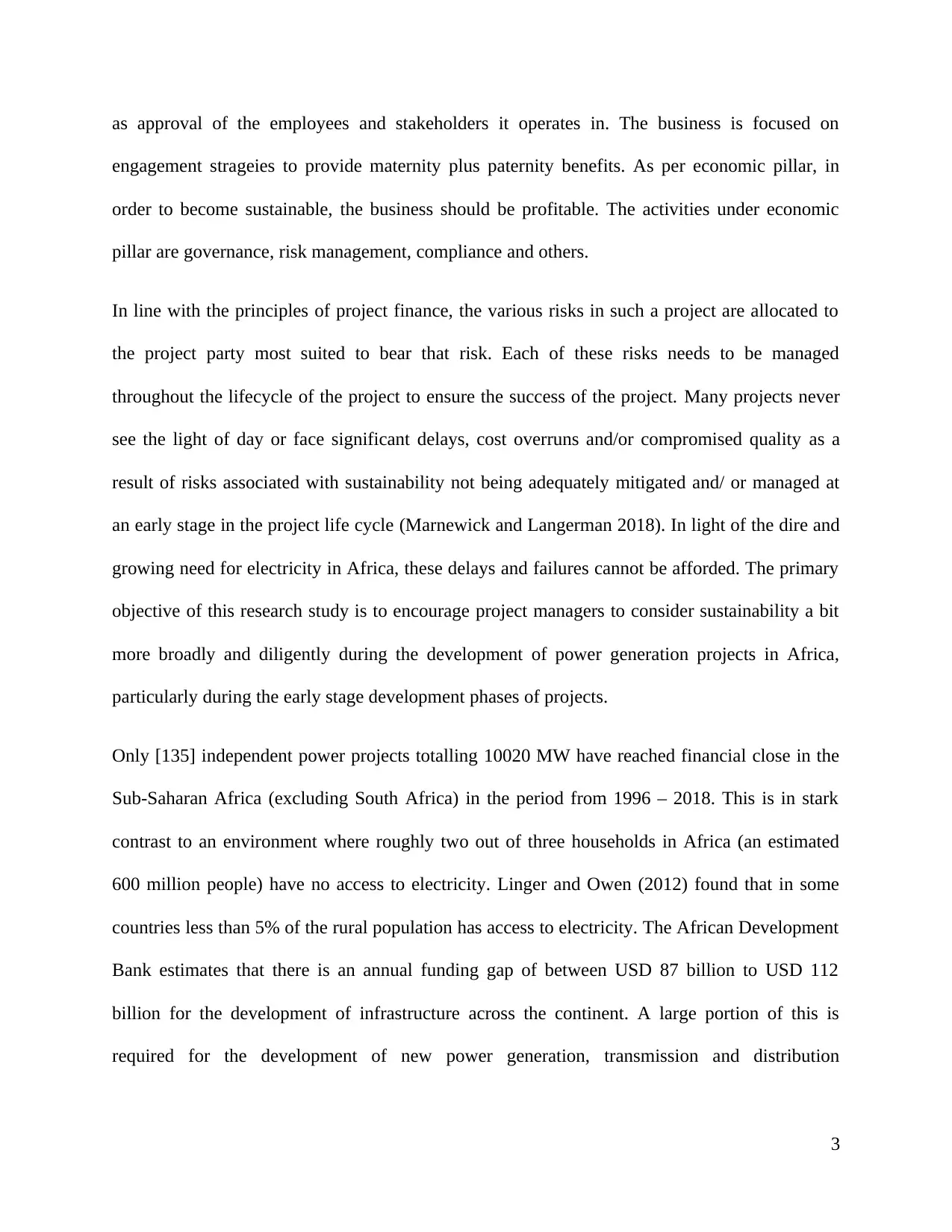
as approval of the employees and stakeholders it operates in. The business is focused on
engagement strageies to provide maternity plus paternity benefits. As per economic pillar, in
order to become sustainable, the business should be profitable. The activities under economic
pillar are governance, risk management, compliance and others.
In line with the principles of project finance, the various risks in such a project are allocated to
the project party most suited to bear that risk. Each of these risks needs to be managed
throughout the lifecycle of the project to ensure the success of the project. Many projects never
see the light of day or face significant delays, cost overruns and/or compromised quality as a
result of risks associated with sustainability not being adequately mitigated and/ or managed at
an early stage in the project life cycle (Marnewick and Langerman 2018). In light of the dire and
growing need for electricity in Africa, these delays and failures cannot be afforded. The primary
objective of this research study is to encourage project managers to consider sustainability a bit
more broadly and diligently during the development of power generation projects in Africa,
particularly during the early stage development phases of projects.
Only [135] independent power projects totalling 10020 MW have reached financial close in the
Sub-Saharan Africa (excluding South Africa) in the period from 1996 – 2018. This is in stark
contrast to an environment where roughly two out of three households in Africa (an estimated
600 million people) have no access to electricity. Linger and Owen (2012) found that in some
countries less than 5% of the rural population has access to electricity. The African Development
Bank estimates that there is an annual funding gap of between USD 87 billion to USD 112
billion for the development of infrastructure across the continent. A large portion of this is
required for the development of new power generation, transmission and distribution
3
engagement strageies to provide maternity plus paternity benefits. As per economic pillar, in
order to become sustainable, the business should be profitable. The activities under economic
pillar are governance, risk management, compliance and others.
In line with the principles of project finance, the various risks in such a project are allocated to
the project party most suited to bear that risk. Each of these risks needs to be managed
throughout the lifecycle of the project to ensure the success of the project. Many projects never
see the light of day or face significant delays, cost overruns and/or compromised quality as a
result of risks associated with sustainability not being adequately mitigated and/ or managed at
an early stage in the project life cycle (Marnewick and Langerman 2018). In light of the dire and
growing need for electricity in Africa, these delays and failures cannot be afforded. The primary
objective of this research study is to encourage project managers to consider sustainability a bit
more broadly and diligently during the development of power generation projects in Africa,
particularly during the early stage development phases of projects.
Only [135] independent power projects totalling 10020 MW have reached financial close in the
Sub-Saharan Africa (excluding South Africa) in the period from 1996 – 2018. This is in stark
contrast to an environment where roughly two out of three households in Africa (an estimated
600 million people) have no access to electricity. Linger and Owen (2012) found that in some
countries less than 5% of the rural population has access to electricity. The African Development
Bank estimates that there is an annual funding gap of between USD 87 billion to USD 112
billion for the development of infrastructure across the continent. A large portion of this is
required for the development of new power generation, transmission and distribution
3
⊘ This is a preview!⊘
Do you want full access?
Subscribe today to unlock all pages.

Trusted by 1+ million students worldwide
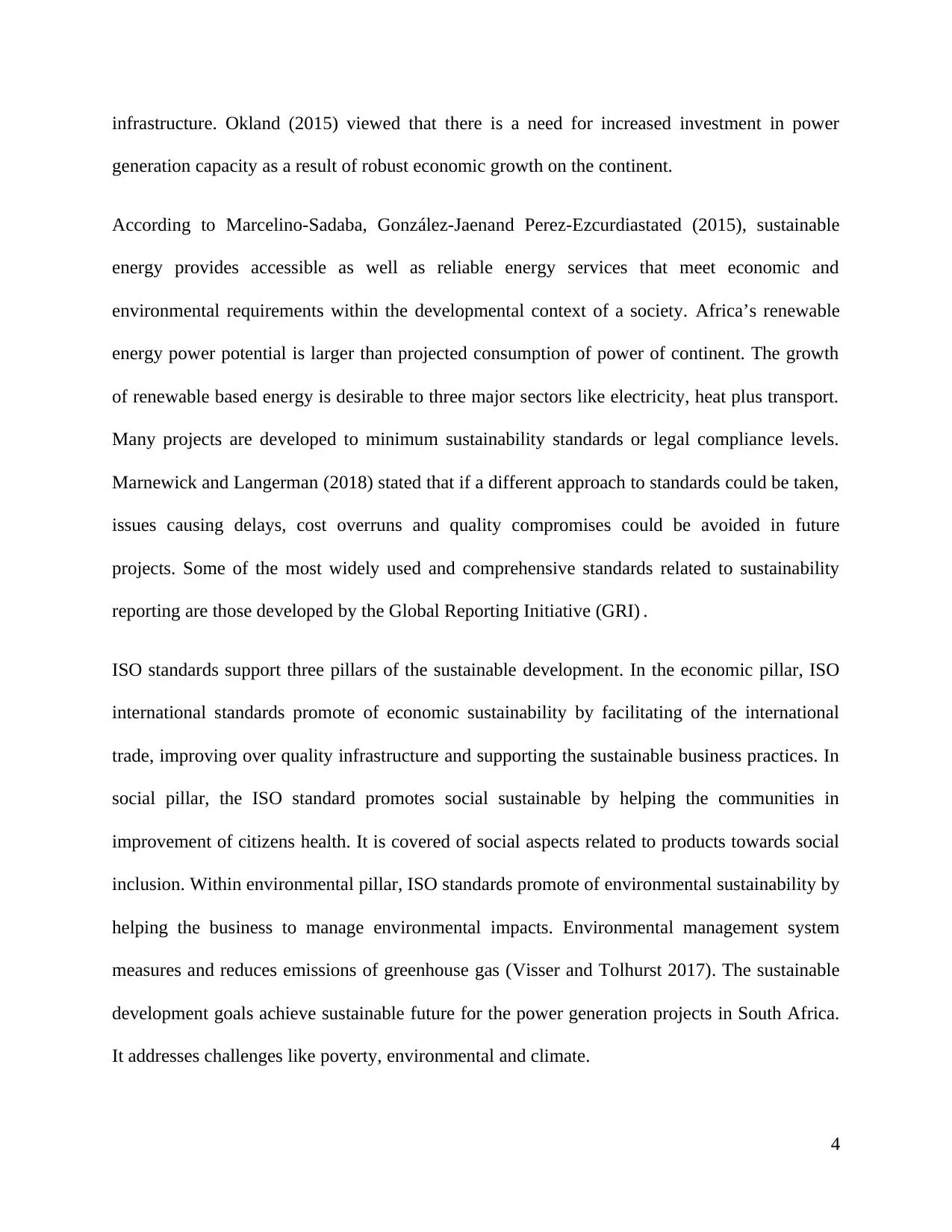
infrastructure. Okland (2015) viewed that there is a need for increased investment in power
generation capacity as a result of robust economic growth on the continent.
According to Marcelino-Sadaba, González-Jaenand Perez-Ezcurdiastated (2015), sustainable
energy provides accessible as well as reliable energy services that meet economic and
environmental requirements within the developmental context of a society. Africa’s renewable
energy power potential is larger than projected consumption of power of continent. The growth
of renewable based energy is desirable to three major sectors like electricity, heat plus transport.
Many projects are developed to minimum sustainability standards or legal compliance levels.
Marnewick and Langerman (2018) stated that if a different approach to standards could be taken,
issues causing delays, cost overruns and quality compromises could be avoided in future
projects. Some of the most widely used and comprehensive standards related to sustainability
reporting are those developed by the Global Reporting Initiative (GRI) .
ISO standards support three pillars of the sustainable development. In the economic pillar, ISO
international standards promote of economic sustainability by facilitating of the international
trade, improving over quality infrastructure and supporting the sustainable business practices. In
social pillar, the ISO standard promotes social sustainable by helping the communities in
improvement of citizens health. It is covered of social aspects related to products towards social
inclusion. Within environmental pillar, ISO standards promote of environmental sustainability by
helping the business to manage environmental impacts. Environmental management system
measures and reduces emissions of greenhouse gas (Visser and Tolhurst 2017). The sustainable
development goals achieve sustainable future for the power generation projects in South Africa.
It addresses challenges like poverty, environmental and climate.
4
generation capacity as a result of robust economic growth on the continent.
According to Marcelino-Sadaba, González-Jaenand Perez-Ezcurdiastated (2015), sustainable
energy provides accessible as well as reliable energy services that meet economic and
environmental requirements within the developmental context of a society. Africa’s renewable
energy power potential is larger than projected consumption of power of continent. The growth
of renewable based energy is desirable to three major sectors like electricity, heat plus transport.
Many projects are developed to minimum sustainability standards or legal compliance levels.
Marnewick and Langerman (2018) stated that if a different approach to standards could be taken,
issues causing delays, cost overruns and quality compromises could be avoided in future
projects. Some of the most widely used and comprehensive standards related to sustainability
reporting are those developed by the Global Reporting Initiative (GRI) .
ISO standards support three pillars of the sustainable development. In the economic pillar, ISO
international standards promote of economic sustainability by facilitating of the international
trade, improving over quality infrastructure and supporting the sustainable business practices. In
social pillar, the ISO standard promotes social sustainable by helping the communities in
improvement of citizens health. It is covered of social aspects related to products towards social
inclusion. Within environmental pillar, ISO standards promote of environmental sustainability by
helping the business to manage environmental impacts. Environmental management system
measures and reduces emissions of greenhouse gas (Visser and Tolhurst 2017). The sustainable
development goals achieve sustainable future for the power generation projects in South Africa.
It addresses challenges like poverty, environmental and climate.
4
Paraphrase This Document
Need a fresh take? Get an instant paraphrase of this document with our AI Paraphraser
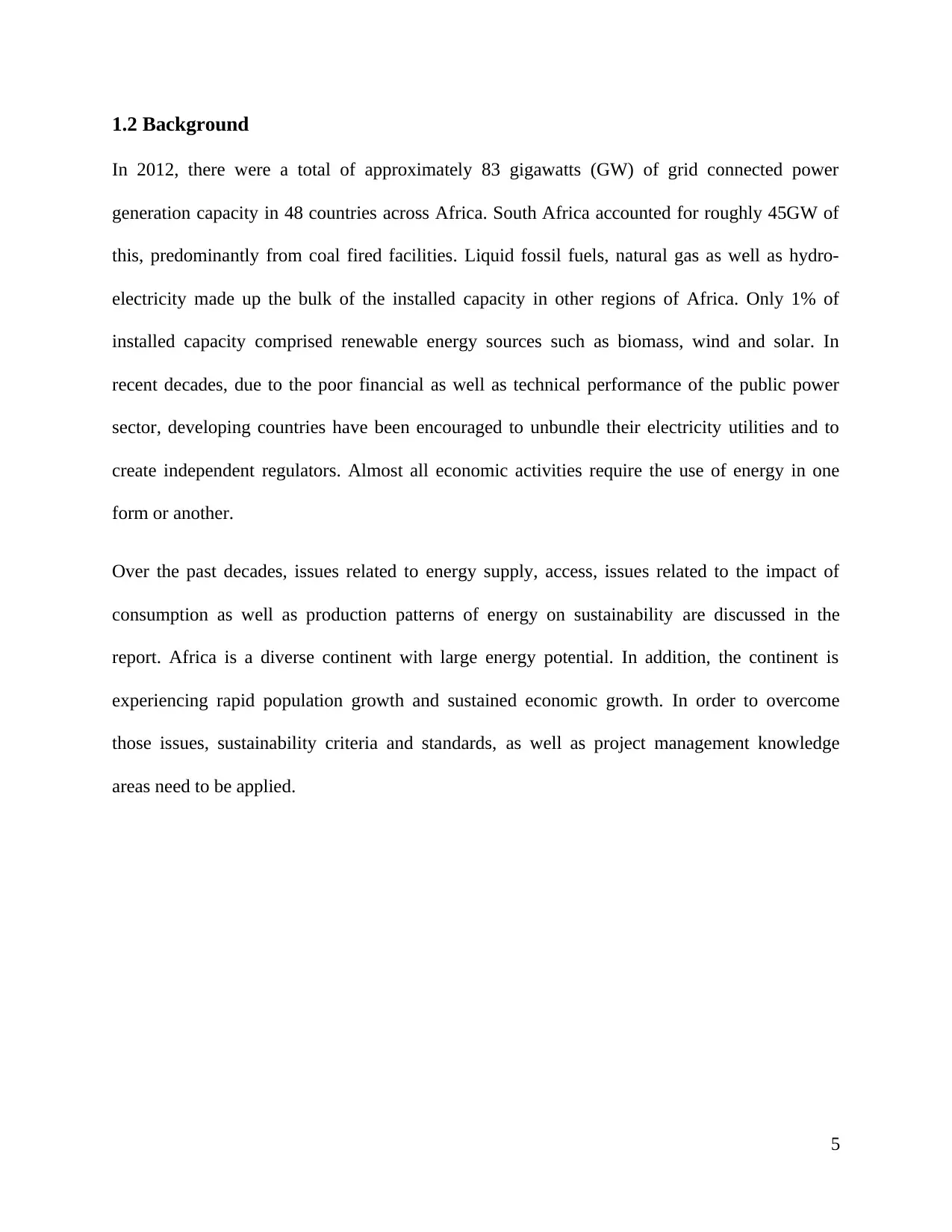
1.2 Background
In 2012, there were a total of approximately 83 gigawatts (GW) of grid connected power
generation capacity in 48 countries across Africa. South Africa accounted for roughly 45GW of
this, predominantly from coal fired facilities. Liquid fossil fuels, natural gas as well as hydro-
electricity made up the bulk of the installed capacity in other regions of Africa. Only 1% of
installed capacity comprised renewable energy sources such as biomass, wind and solar. In
recent decades, due to the poor financial as well as technical performance of the public power
sector, developing countries have been encouraged to unbundle their electricity utilities and to
create independent regulators. Almost all economic activities require the use of energy in one
form or another.
Over the past decades, issues related to energy supply, access, issues related to the impact of
consumption as well as production patterns of energy on sustainability are discussed in the
report. Africa is a diverse continent with large energy potential. In addition, the continent is
experiencing rapid population growth and sustained economic growth. In order to overcome
those issues, sustainability criteria and standards, as well as project management knowledge
areas need to be applied.
5
In 2012, there were a total of approximately 83 gigawatts (GW) of grid connected power
generation capacity in 48 countries across Africa. South Africa accounted for roughly 45GW of
this, predominantly from coal fired facilities. Liquid fossil fuels, natural gas as well as hydro-
electricity made up the bulk of the installed capacity in other regions of Africa. Only 1% of
installed capacity comprised renewable energy sources such as biomass, wind and solar. In
recent decades, due to the poor financial as well as technical performance of the public power
sector, developing countries have been encouraged to unbundle their electricity utilities and to
create independent regulators. Almost all economic activities require the use of energy in one
form or another.
Over the past decades, issues related to energy supply, access, issues related to the impact of
consumption as well as production patterns of energy on sustainability are discussed in the
report. Africa is a diverse continent with large energy potential. In addition, the continent is
experiencing rapid population growth and sustained economic growth. In order to overcome
those issues, sustainability criteria and standards, as well as project management knowledge
areas need to be applied.
5
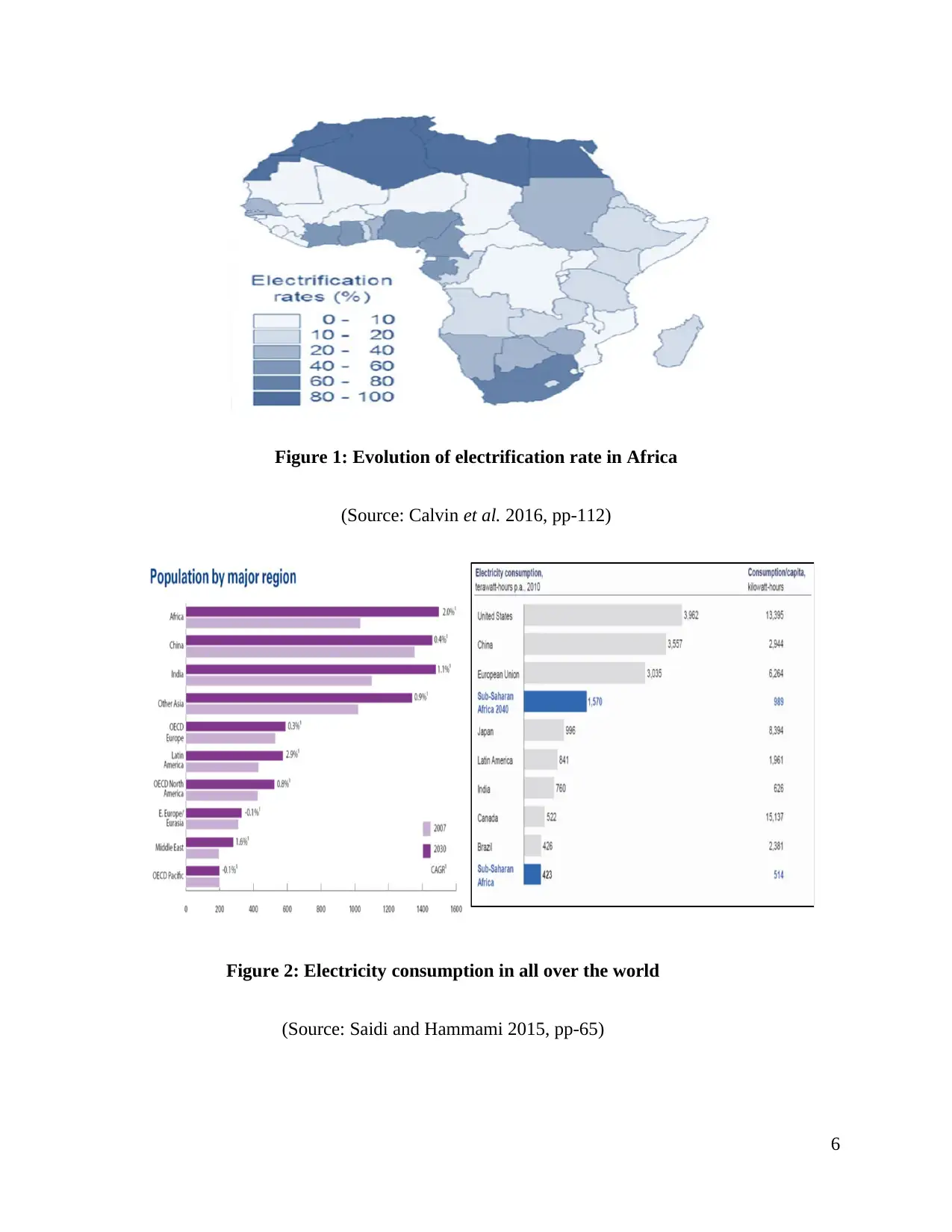
Figure 1: Evolution of electrification rate in Africa
(Source: Calvin et al. 2016, pp-112)
Figure 2: Electricity consumption in all over the world
(Source: Saidi and Hammami 2015, pp-65)
6
(Source: Calvin et al. 2016, pp-112)
Figure 2: Electricity consumption in all over the world
(Source: Saidi and Hammami 2015, pp-65)
6
⊘ This is a preview!⊘
Do you want full access?
Subscribe today to unlock all pages.

Trusted by 1+ million students worldwide
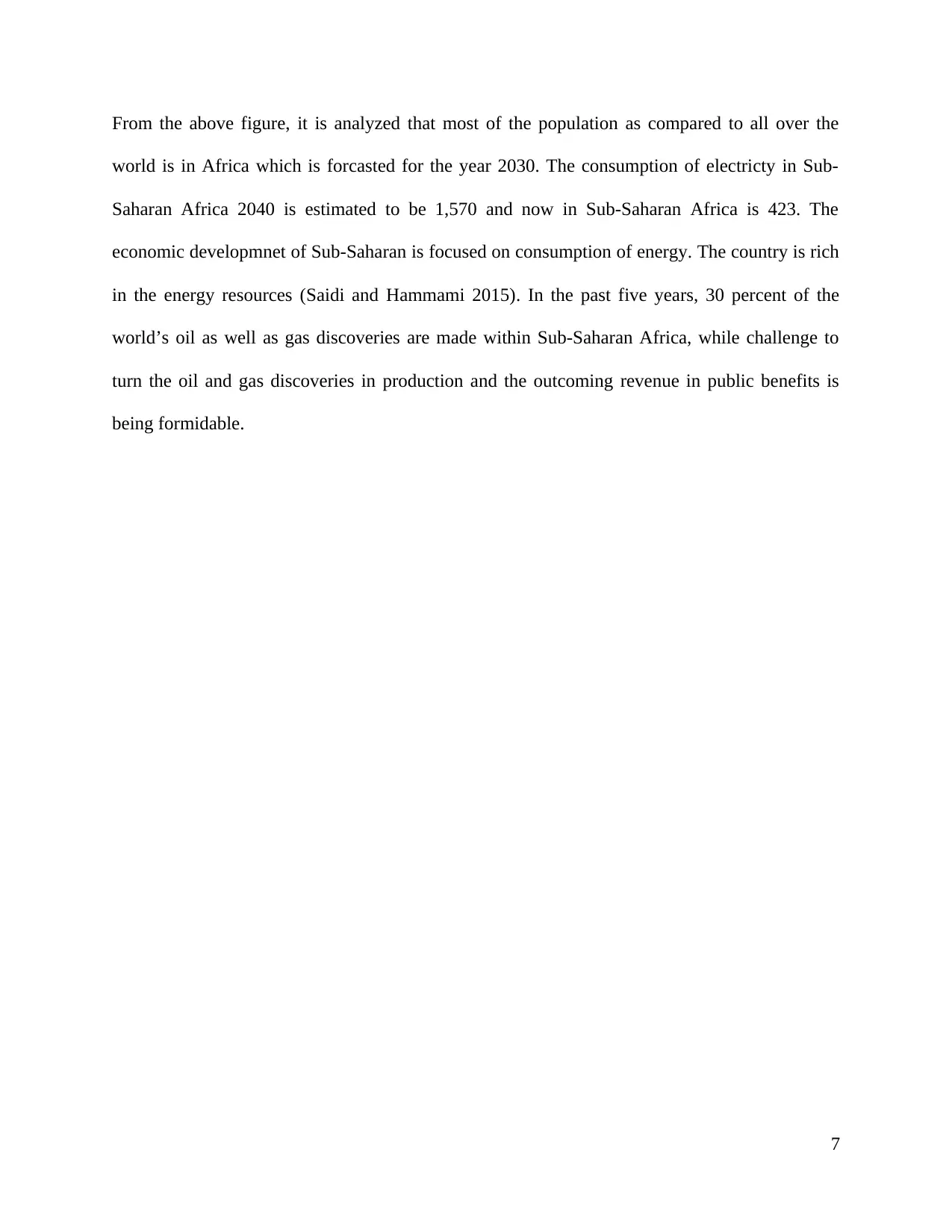
From the above figure, it is analyzed that most of the population as compared to all over the
world is in Africa which is forcasted for the year 2030. The consumption of electricty in Sub-
Saharan Africa 2040 is estimated to be 1,570 and now in Sub-Saharan Africa is 423. The
economic developmnet of Sub-Saharan is focused on consumption of energy. The country is rich
in the energy resources (Saidi and Hammami 2015). In the past five years, 30 percent of the
world’s oil as well as gas discoveries are made within Sub-Saharan Africa, while challenge to
turn the oil and gas discoveries in production and the outcoming revenue in public benefits is
being formidable.
7
world is in Africa which is forcasted for the year 2030. The consumption of electricty in Sub-
Saharan Africa 2040 is estimated to be 1,570 and now in Sub-Saharan Africa is 423. The
economic developmnet of Sub-Saharan is focused on consumption of energy. The country is rich
in the energy resources (Saidi and Hammami 2015). In the past five years, 30 percent of the
world’s oil as well as gas discoveries are made within Sub-Saharan Africa, while challenge to
turn the oil and gas discoveries in production and the outcoming revenue in public benefits is
being formidable.
7
Paraphrase This Document
Need a fresh take? Get an instant paraphrase of this document with our AI Paraphraser
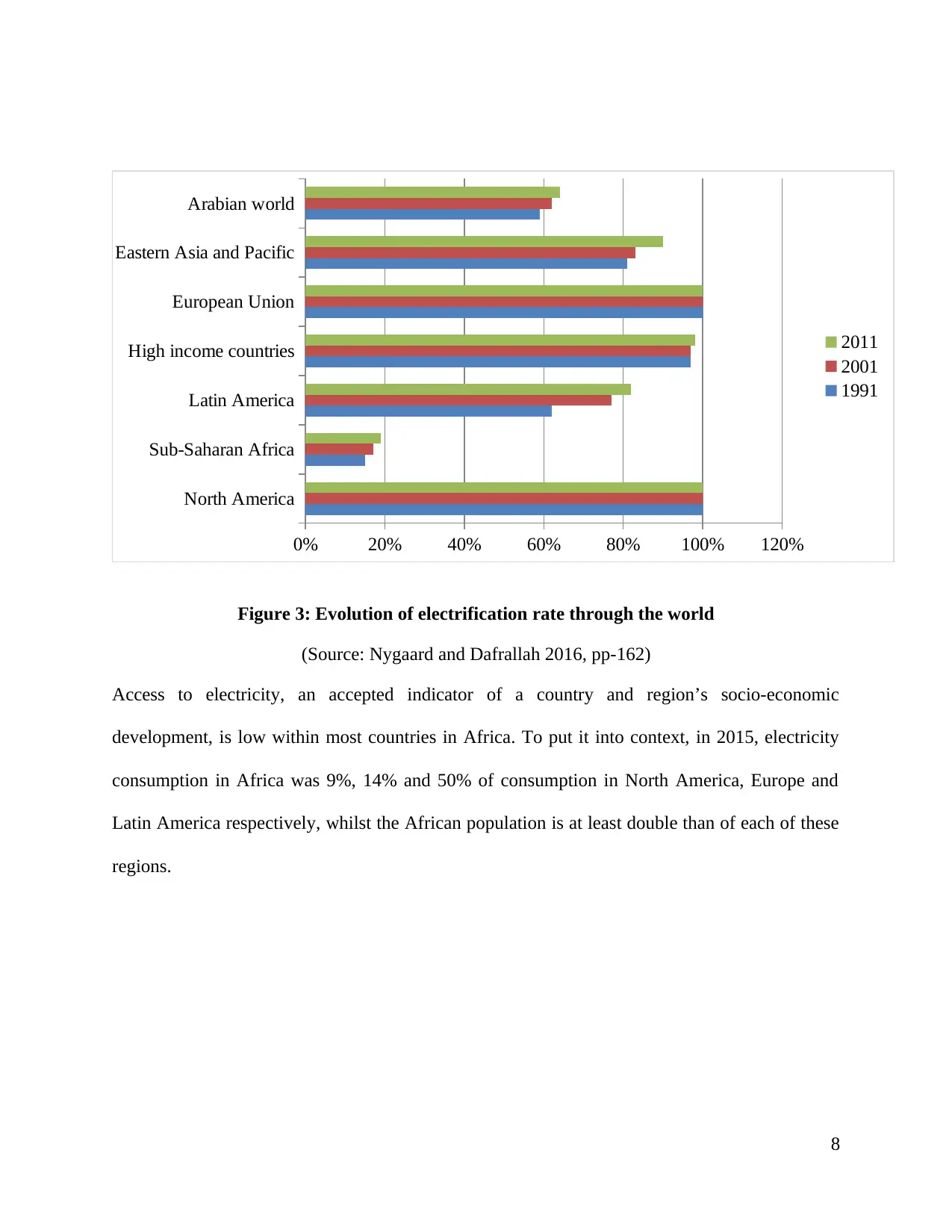
Figure 3: Evolution of electrification rate through the world
(Source: Nygaard and Dafrallah 2016, pp-162)
Access to electricity, an accepted indicator of a country and region’s socio-economic
development, is low within most countries in Africa. To put it into context, in 2015, electricity
consumption in Africa was 9%, 14% and 50% of consumption in North America, Europe and
Latin America respectively, whilst the African population is at least double than of each of these
regions.
8
North America
Sub-Saharan Africa
Latin America
High income countries
European Union
Eastern Asia and Pacific
Arabian world
0% 20% 40% 60% 80% 100% 120%
2011
2001
1991
(Source: Nygaard and Dafrallah 2016, pp-162)
Access to electricity, an accepted indicator of a country and region’s socio-economic
development, is low within most countries in Africa. To put it into context, in 2015, electricity
consumption in Africa was 9%, 14% and 50% of consumption in North America, Europe and
Latin America respectively, whilst the African population is at least double than of each of these
regions.
8
North America
Sub-Saharan Africa
Latin America
High income countries
European Union
Eastern Asia and Pacific
Arabian world
0% 20% 40% 60% 80% 100% 120%
2011
2001
1991
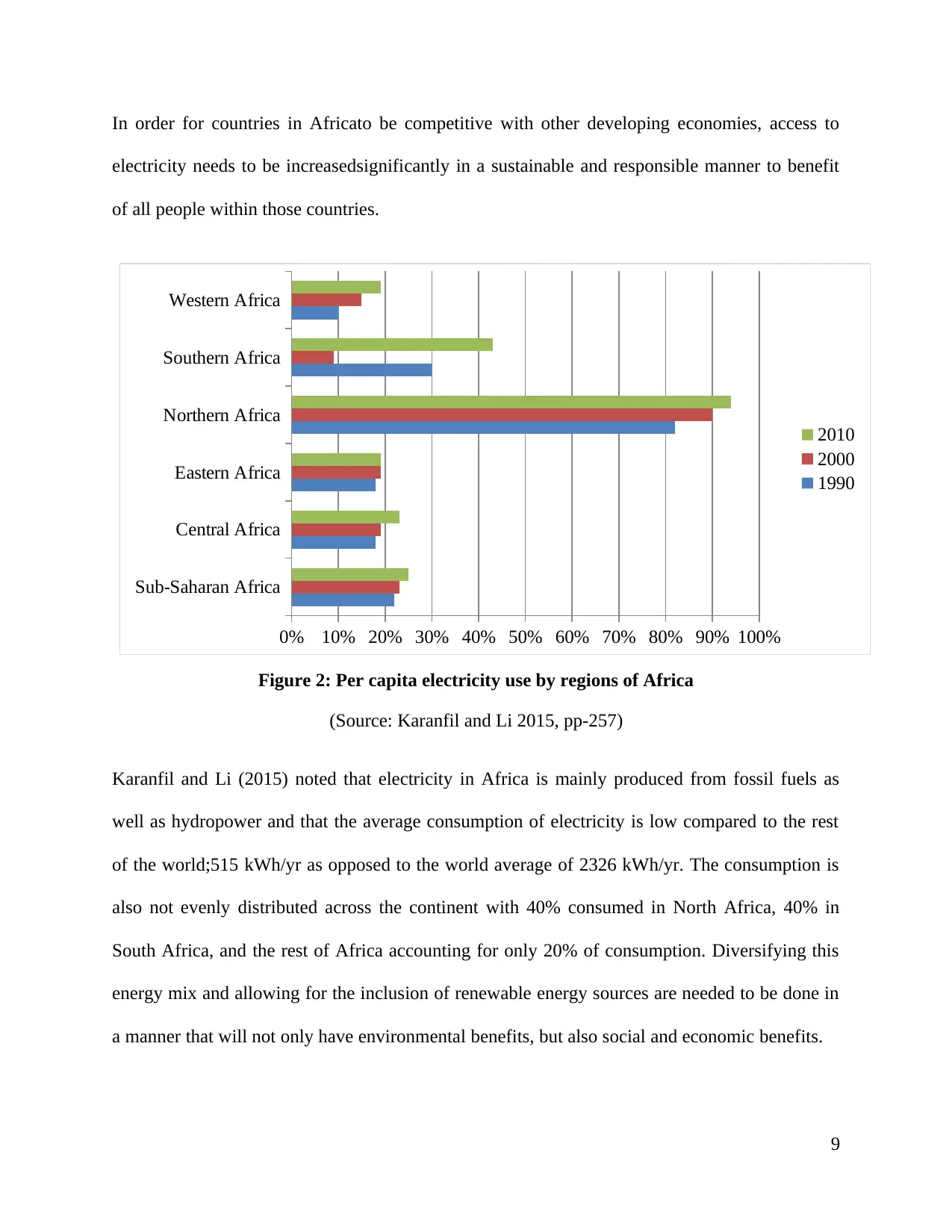
In order for countries in Africato be competitive with other developing economies, access to
electricity needs to be increasedsignificantly in a sustainable and responsible manner to benefit
of all people within those countries.
Figure 2: Per capita electricity use by regions of Africa
(Source: Karanfil and Li 2015, pp-257)
Karanfil and Li (2015) noted that electricity in Africa is mainly produced from fossil fuels as
well as hydropower and that the average consumption of electricity is low compared to the rest
of the world;515 kWh/yr as opposed to the world average of 2326 kWh/yr. The consumption is
also not evenly distributed across the continent with 40% consumed in North Africa, 40% in
South Africa, and the rest of Africa accounting for only 20% of consumption. Diversifying this
energy mix and allowing for the inclusion of renewable energy sources are needed to be done in
a manner that will not only have environmental benefits, but also social and economic benefits.
9
Sub-Saharan Africa
Central Africa
Eastern Africa
Northern Africa
Southern Africa
Western Africa
0% 10% 20% 30% 40% 50% 60% 70% 80% 90% 100%
2010
2000
1990
electricity needs to be increasedsignificantly in a sustainable and responsible manner to benefit
of all people within those countries.
Figure 2: Per capita electricity use by regions of Africa
(Source: Karanfil and Li 2015, pp-257)
Karanfil and Li (2015) noted that electricity in Africa is mainly produced from fossil fuels as
well as hydropower and that the average consumption of electricity is low compared to the rest
of the world;515 kWh/yr as opposed to the world average of 2326 kWh/yr. The consumption is
also not evenly distributed across the continent with 40% consumed in North Africa, 40% in
South Africa, and the rest of Africa accounting for only 20% of consumption. Diversifying this
energy mix and allowing for the inclusion of renewable energy sources are needed to be done in
a manner that will not only have environmental benefits, but also social and economic benefits.
9
Sub-Saharan Africa
Central Africa
Eastern Africa
Northern Africa
Southern Africa
Western Africa
0% 10% 20% 30% 40% 50% 60% 70% 80% 90% 100%
2010
2000
1990
⊘ This is a preview!⊘
Do you want full access?
Subscribe today to unlock all pages.

Trusted by 1+ million students worldwide
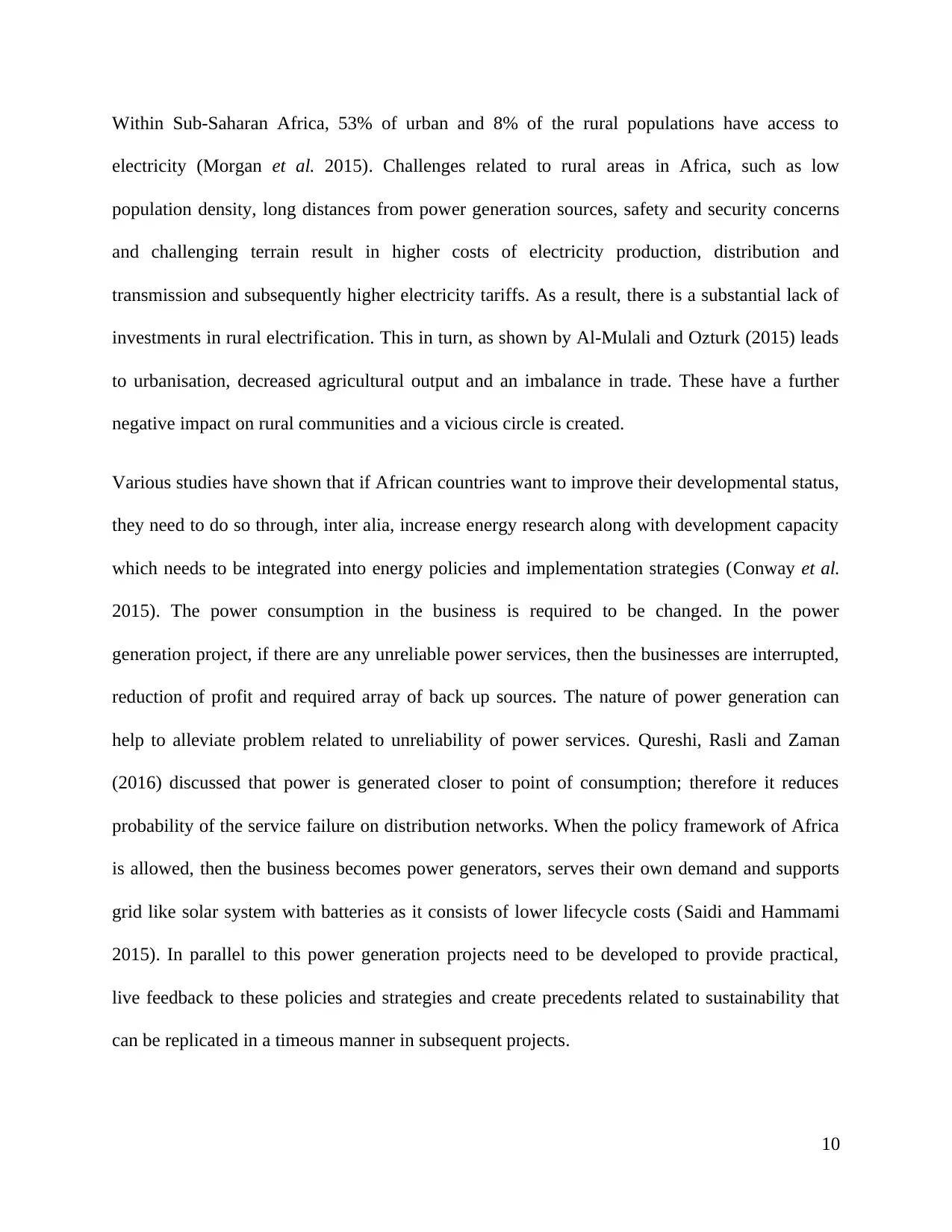
Within Sub-Saharan Africa, 53% of urban and 8% of the rural populations have access to
electricity (Morgan et al. 2015). Challenges related to rural areas in Africa, such as low
population density, long distances from power generation sources, safety and security concerns
and challenging terrain result in higher costs of electricity production, distribution and
transmission and subsequently higher electricity tariffs. As a result, there is a substantial lack of
investments in rural electrification. This in turn, as shown by Al-Mulali and Ozturk (2015) leads
to urbanisation, decreased agricultural output and an imbalance in trade. These have a further
negative impact on rural communities and a vicious circle is created.
Various studies have shown that if African countries want to improve their developmental status,
they need to do so through, inter alia, increase energy research along with development capacity
which needs to be integrated into energy policies and implementation strategies (Conway et al.
2015). The power consumption in the business is required to be changed. In the power
generation project, if there are any unreliable power services, then the businesses are interrupted,
reduction of profit and required array of back up sources. The nature of power generation can
help to alleviate problem related to unreliability of power services. Qureshi, Rasli and Zaman
(2016) discussed that power is generated closer to point of consumption; therefore it reduces
probability of the service failure on distribution networks. When the policy framework of Africa
is allowed, then the business becomes power generators, serves their own demand and supports
grid like solar system with batteries as it consists of lower lifecycle costs (Saidi and Hammami
2015). In parallel to this power generation projects need to be developed to provide practical,
live feedback to these policies and strategies and create precedents related to sustainability that
can be replicated in a timeous manner in subsequent projects.
10
electricity (Morgan et al. 2015). Challenges related to rural areas in Africa, such as low
population density, long distances from power generation sources, safety and security concerns
and challenging terrain result in higher costs of electricity production, distribution and
transmission and subsequently higher electricity tariffs. As a result, there is a substantial lack of
investments in rural electrification. This in turn, as shown by Al-Mulali and Ozturk (2015) leads
to urbanisation, decreased agricultural output and an imbalance in trade. These have a further
negative impact on rural communities and a vicious circle is created.
Various studies have shown that if African countries want to improve their developmental status,
they need to do so through, inter alia, increase energy research along with development capacity
which needs to be integrated into energy policies and implementation strategies (Conway et al.
2015). The power consumption in the business is required to be changed. In the power
generation project, if there are any unreliable power services, then the businesses are interrupted,
reduction of profit and required array of back up sources. The nature of power generation can
help to alleviate problem related to unreliability of power services. Qureshi, Rasli and Zaman
(2016) discussed that power is generated closer to point of consumption; therefore it reduces
probability of the service failure on distribution networks. When the policy framework of Africa
is allowed, then the business becomes power generators, serves their own demand and supports
grid like solar system with batteries as it consists of lower lifecycle costs (Saidi and Hammami
2015). In parallel to this power generation projects need to be developed to provide practical,
live feedback to these policies and strategies and create precedents related to sustainability that
can be replicated in a timeous manner in subsequent projects.
10
Paraphrase This Document
Need a fresh take? Get an instant paraphrase of this document with our AI Paraphraser
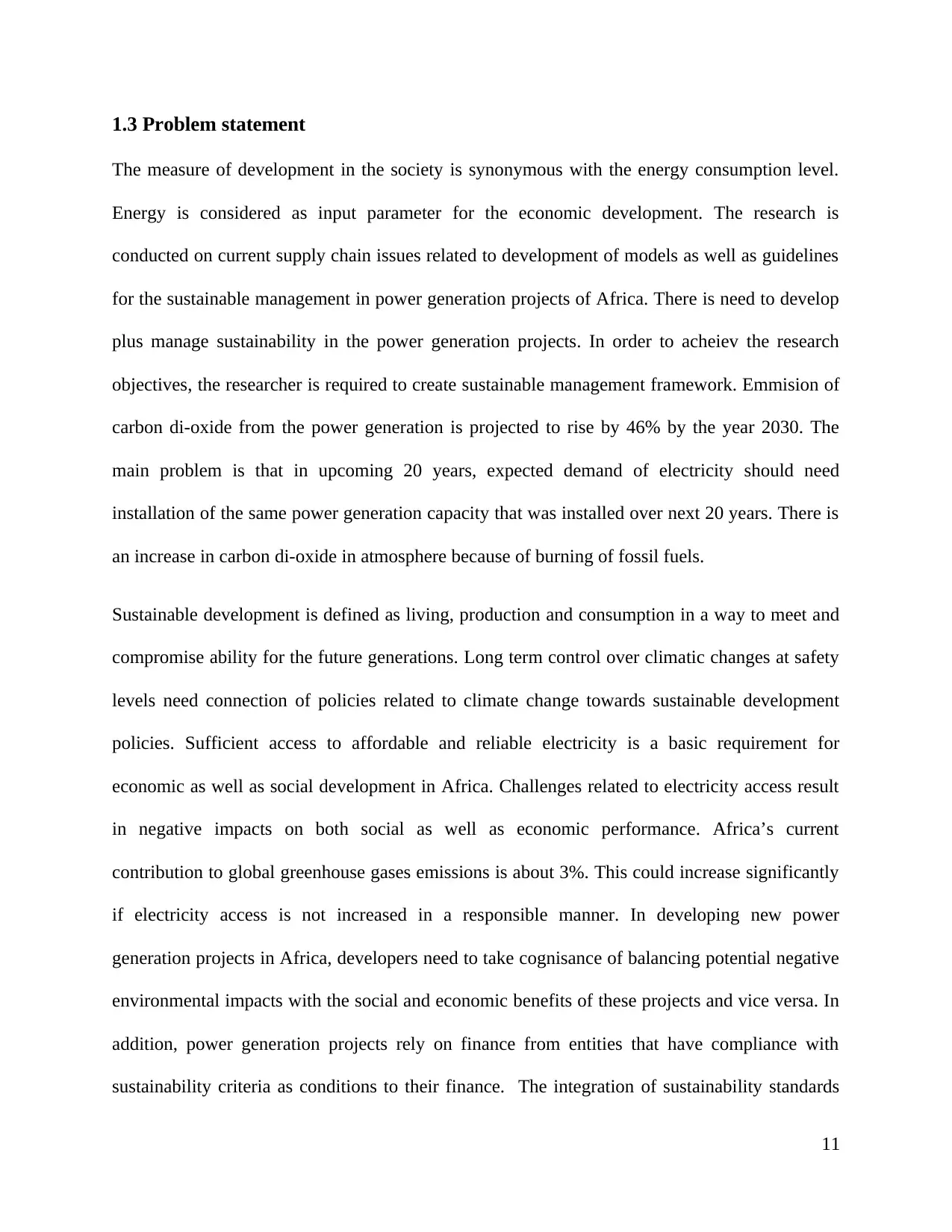
1.3 Problem statement
The measure of development in the society is synonymous with the energy consumption level.
Energy is considered as input parameter for the economic development. The research is
conducted on current supply chain issues related to development of models as well as guidelines
for the sustainable management in power generation projects of Africa. There is need to develop
plus manage sustainability in the power generation projects. In order to acheiev the research
objectives, the researcher is required to create sustainable management framework. Emmision of
carbon di-oxide from the power generation is projected to rise by 46% by the year 2030. The
main problem is that in upcoming 20 years, expected demand of electricity should need
installation of the same power generation capacity that was installed over next 20 years. There is
an increase in carbon di-oxide in atmosphere because of burning of fossil fuels.
Sustainable development is defined as living, production and consumption in a way to meet and
compromise ability for the future generations. Long term control over climatic changes at safety
levels need connection of policies related to climate change towards sustainable development
policies. Sufficient access to affordable and reliable electricity is a basic requirement for
economic as well as social development in Africa. Challenges related to electricity access result
in negative impacts on both social as well as economic performance. Africa’s current
contribution to global greenhouse gases emissions is about 3%. This could increase significantly
if electricity access is not increased in a responsible manner. In developing new power
generation projects in Africa, developers need to take cognisance of balancing potential negative
environmental impacts with the social and economic benefits of these projects and vice versa. In
addition, power generation projects rely on finance from entities that have compliance with
sustainability criteria as conditions to their finance. The integration of sustainability standards
11
The measure of development in the society is synonymous with the energy consumption level.
Energy is considered as input parameter for the economic development. The research is
conducted on current supply chain issues related to development of models as well as guidelines
for the sustainable management in power generation projects of Africa. There is need to develop
plus manage sustainability in the power generation projects. In order to acheiev the research
objectives, the researcher is required to create sustainable management framework. Emmision of
carbon di-oxide from the power generation is projected to rise by 46% by the year 2030. The
main problem is that in upcoming 20 years, expected demand of electricity should need
installation of the same power generation capacity that was installed over next 20 years. There is
an increase in carbon di-oxide in atmosphere because of burning of fossil fuels.
Sustainable development is defined as living, production and consumption in a way to meet and
compromise ability for the future generations. Long term control over climatic changes at safety
levels need connection of policies related to climate change towards sustainable development
policies. Sufficient access to affordable and reliable electricity is a basic requirement for
economic as well as social development in Africa. Challenges related to electricity access result
in negative impacts on both social as well as economic performance. Africa’s current
contribution to global greenhouse gases emissions is about 3%. This could increase significantly
if electricity access is not increased in a responsible manner. In developing new power
generation projects in Africa, developers need to take cognisance of balancing potential negative
environmental impacts with the social and economic benefits of these projects and vice versa. In
addition, power generation projects rely on finance from entities that have compliance with
sustainability criteria as conditions to their finance. The integration of sustainability standards
11
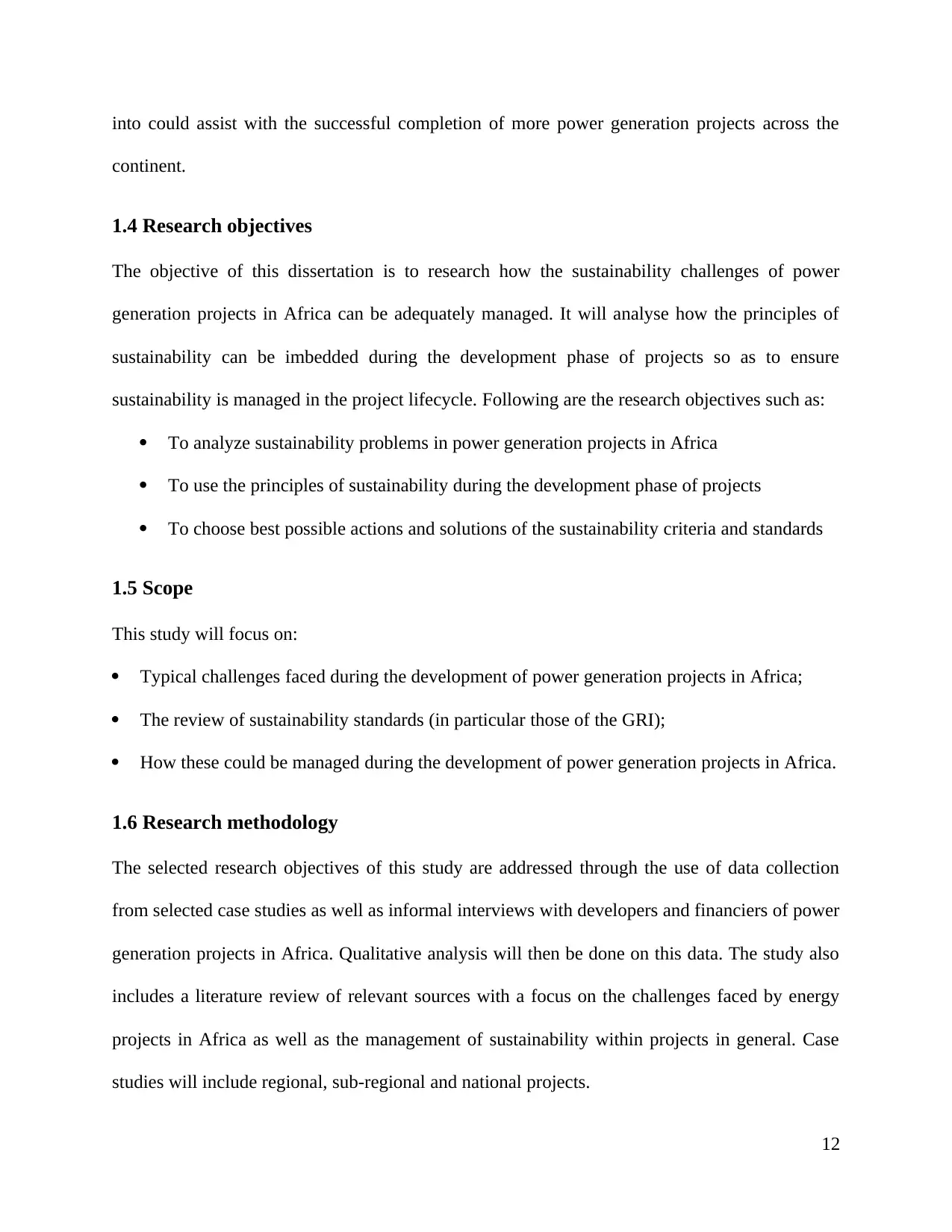
into could assist with the successful completion of more power generation projects across the
continent.
1.4 Research objectives
The objective of this dissertation is to research how the sustainability challenges of power
generation projects in Africa can be adequately managed. It will analyse how the principles of
sustainability can be imbedded during the development phase of projects so as to ensure
sustainability is managed in the project lifecycle. Following are the research objectives such as:
To analyze sustainability problems in power generation projects in Africa
To use the principles of sustainability during the development phase of projects
To choose best possible actions and solutions of the sustainability criteria and standards
1.5 Scope
This study will focus on:
Typical challenges faced during the development of power generation projects in Africa;
The review of sustainability standards (in particular those of the GRI);
How these could be managed during the development of power generation projects in Africa.
1.6 Research methodology
The selected research objectives of this study are addressed through the use of data collection
from selected case studies as well as informal interviews with developers and financiers of power
generation projects in Africa. Qualitative analysis will then be done on this data. The study also
includes a literature review of relevant sources with a focus on the challenges faced by energy
projects in Africa as well as the management of sustainability within projects in general. Case
studies will include regional, sub-regional and national projects.
12
continent.
1.4 Research objectives
The objective of this dissertation is to research how the sustainability challenges of power
generation projects in Africa can be adequately managed. It will analyse how the principles of
sustainability can be imbedded during the development phase of projects so as to ensure
sustainability is managed in the project lifecycle. Following are the research objectives such as:
To analyze sustainability problems in power generation projects in Africa
To use the principles of sustainability during the development phase of projects
To choose best possible actions and solutions of the sustainability criteria and standards
1.5 Scope
This study will focus on:
Typical challenges faced during the development of power generation projects in Africa;
The review of sustainability standards (in particular those of the GRI);
How these could be managed during the development of power generation projects in Africa.
1.6 Research methodology
The selected research objectives of this study are addressed through the use of data collection
from selected case studies as well as informal interviews with developers and financiers of power
generation projects in Africa. Qualitative analysis will then be done on this data. The study also
includes a literature review of relevant sources with a focus on the challenges faced by energy
projects in Africa as well as the management of sustainability within projects in general. Case
studies will include regional, sub-regional and national projects.
12
⊘ This is a preview!⊘
Do you want full access?
Subscribe today to unlock all pages.

Trusted by 1+ million students worldwide
1 out of 50
Related Documents
Your All-in-One AI-Powered Toolkit for Academic Success.
+13062052269
info@desklib.com
Available 24*7 on WhatsApp / Email
![[object Object]](/_next/static/media/star-bottom.7253800d.svg)
Unlock your academic potential
Copyright © 2020–2025 A2Z Services. All Rights Reserved. Developed and managed by ZUCOL.




